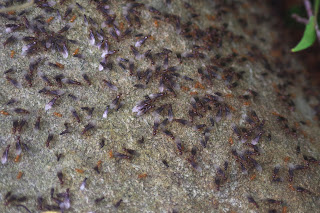There are a couple of metrics that give a sense of how successful I was on a given day in finding bugs–how long my bug walk takes, and how many pictures I take. If I don't find much, it doesn't take long. In general when I go out I expect to be out for an hour. Today I was out for over two. Most days this year I have taken between 100 and 200 pictures; on good days it's been about 250. Yesterday it was 60, and about 20 of them were of a rabbit. Today I took 451. Now, that in itself doesn't always mean I found a lot of bugs, because sometimes I take over 100 pictures of one bug, trying to get a good shot. And during my bug walk today, toward the beginning, I thought that if I ended up with a lot of pictures today it would be because I took a lot of pictures of a net-winged beetle. But I didn't take 300 pictures of it. 451 pictures in a day wouldn't be a huge number in other summers, but this summer... well, it's the most pictures I have taken in a day this summer, I think. So yes, today was a successful bug walk by the numbers. But it was also interesting, and varied, and fun, and those are much more important than the numbers. I saw interesting bug behaviors, and interactions that were, in their tiny way, exciting to watch. It was a good day in the backyard.
Backyard Bug of the Day:
I can't find the specific species in my bug books, so I tried my caterpillar book. That's not a great way to identify a moth, because of the way the moths are shown in the pictures, with their wings splayed out, not in the natural way the moths hold them, but it is possible that this is a juniper geometer moth. It used to be an inchworm type caterpillar.
The human brain is programmed to look for patterns in things, which no doubt was very helpful back when we had to search for our food instead of getting it at the grocery store. I tend to see patterns in a lot of strange things that aren't really patterns. For instance, today there was something of a theme on my bug walk of finding insects of the order Orthoptera on goldenrod plants. After finding grasshoppers and katydids on goldenrod, I was hoping to find a cricket on goldenrod, to complete the set–or the pattern, as I saw it, of each category of Orthoptera on goldenrod. So, did I find what I was looking for? Let's see...
Actually, the first katydid that I found was on milkweed, the same milkweed plant where I so often find meadow katydids:
A male one was there today.
Here's a meadow katydid on goldenrod. Also a male.Red-legged grasshoppers on goldenrod:
I think this one is a male.
It's hard to tell, but the end of his abdomen is rounded.
As a bonus Orthoptera, a female katydid on a cucamelon. In case you are thinking that this must be an enormous insect, it's not. Cucamelons are small.
Other Bugs:
On the left, the first ever hazelnut produced by this tree. On the right, a leaf hopper.
Sweat bee on goldenrod
Interesting things have been happening in the milkweed patch:
Several of the large milkweed bugs have reached their adult stage. I am sure you can tell that they are the ones with wing covers. When they first molt their colors are pale, and you can tell that these adults are in various stages of color.
Contrast the one on the bottom, which is obviously the one most recently molted, to the one walking over its head, that looks like it is its normal color, or at least close to it.
More interesting insect happenings:
... on a nearby leaf I found the other one. And the stinkbug.
The autumn joy sedum was popular again today:
There were several species of bees there today, including honeybees.
Buffalo tree hopper
I mentioned a net-winged beetle:
On Japanese knotweed
A fun thing about net-winged beetles is they flex their elytra a lot, waving them open and closed. I have no idea why, but it's almost like a dance when you watch them.
I found some ants that were beginning to swarm:
The colony produces a generation of ants that have wings, and can fly away to start new colonies.
Notice there are two different sizes of winged ants, and some without wings that will stay behind. I don't know what the two sizes are for; I would have said the larger ones were potential queens, but that seems like a lot of queens.
Assassin bug with prey
Arachnid Appreciation:
.
.
.
.
.
.
.
.
.
.
.
.
Of course, when I moved to the other side of the web to get pictures of the other side, the spider zoomed up to the top of the web.
I found an interesting scene on the thistle:
... moves in for the kill...
A honeybee arrived, the spider retreated, and on the right of the picture you can see the sweat bee flying away. I don't think the honeybee had even noticed the sweat bee, and was assuredly not trying to rescue it, but it did.
Eventually the honeybee had the flower to itself. I don't know where the spider ended up.










































No comments:
Post a Comment